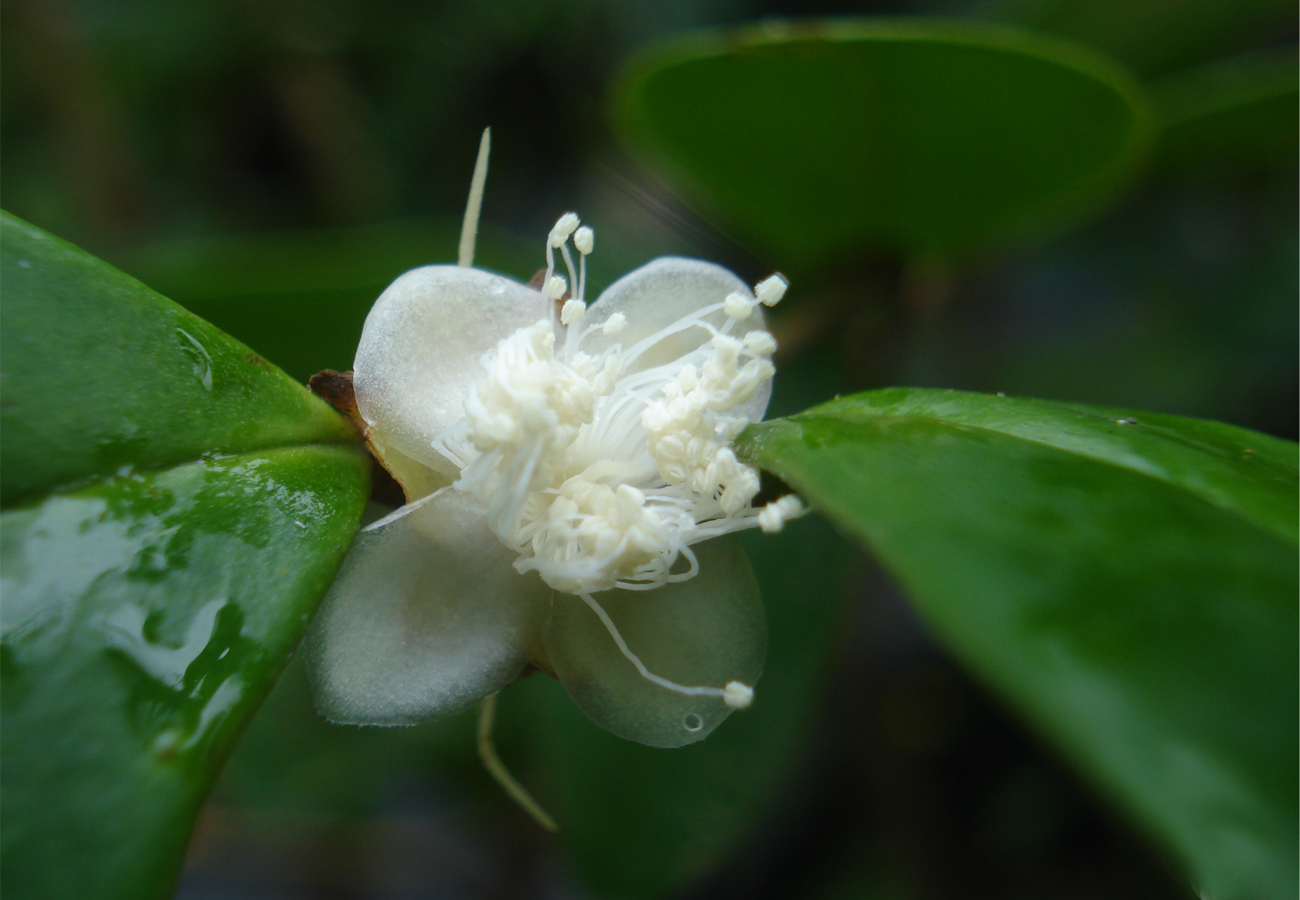Abstract
Although Eugenia and Plinia genera belong to different subtribes in Myrteae (Myrtaceae), shared morphological features have led to frequent mistaken identity to these species. Molecular phylogeny and morphological studies in Plinia show that Plinia martinellii and Plinia sebastianopolitana should be combined within the generic concept of Eugenia. In addition, two synonymizations under Plinia sebastianopolitana and one under Plinia martinellii are proposed. Commentary on these nnomenclatural adjustments, as well as on morphological and geographical data related to the evolution of these lineages is also provided.
References
Barroso, G.M. (1994) Myrtaceae do sudeste do Brasil: espécies novas do gênero Plinia Linnaeus. Napaea 10: 1–5.
Barroso, G.M. & Peron, M. (1994) Myrtaceae. In: Lima, M.P.M. & Guedes-Bruni, R.R. (Orgs.) Reserva ecológica de Macaé de Cima, Nova Friburgo, RJ. Aspectos florísticos das espécies vasculares. v. 1, p. 261–302.
Berg, O. (1856) Revisio Myrtacearum Americae. Linnaea 27: 1–472.
Berg, O. (1857–1859) Myrtaceae. Flora Brasiliensis 14 (1): 1–656.
Bünger, M.O., Mazine, F.F., Forest, F., Bueno, M.L., Stehmann, J.R. & Lucas, E.J. (2016) The evolutionary history of Eugenia sect. Phyllocalyx (Myrtaceae) corroborates historically stable areas in the southern Atlantic forests. Annals of Botany 118: 1209–1223. https://doi.org/10.1093/aob/mcw209
De Candolle, A.P. (1828) Prodromus Systematis Naturalis Regni Vegetabilis 3: 273 pp.
Doyle, J.J. & Doyle, J.L. (1987) A rapid DNA isolation procedure for small quantities of fresh leaf tissue. Phytochemical Bulletin 19: 11–15.
Edgar, R.C. (2004) MUSCLE: a multiple sequence alignment method with reduced time and space complexity. BMC Bioinformatics 5 (1): 1–113.
Govaerts, R., Sobral, M., Ashton, P., Barrie, F., Holts, B.K., Landrum, L.L., Matsumoto, K., Mazine, F.F., Nic Lughadha, E., Proença, C., Soares-Silva, L.H., Wilson, P.G. & Lucas, E. (2019) World Checklist of Selected Plant Families not World Checklist of Myrtaceae. The Board of Trustees of the Royal Botanic Gardens, Kew. Available from: http://apps.kew.org/wcsp/myrtaceae/ (accessed 11 August 2019)
Holst, B., Landrum, L. & Grifo (2003) Flora of the Venezuelan Guayana. Volume 7: Myrtaceae-Plumbaginaceae. Missouri Botanical Garden Press, St. Louis, USA, pp. 1–100.
Kausel, E. (1966) Lista de las Mirtaceas y Leptospermaceas argentinas. Lilloa 32: 323–368.
Kearse, M., Moir, R., Wilson, A., Stones-Havas, S., Cheung, M., Sturrock, S., Buxton, S., Cooper, A., Markowitz, S., Duran, C., Thierer, T., Ashton, B., Mentjies, P. & Drummond, A. (2012) Geneious Basic: an integrated and extendable desktop software platform for the organization and analysis of sequence data. Bioinformatics 28: 1647–1649. https://doi.org/10.1093/bioinformatics/bts199
Kuntze, C. (1898) Revisio generum plantarum. v. 3, 576 p.
Linnaeus, C. (1753) Species Plantarum. Stockholm: Impensis Laurentii Salvii, 560 pp.
Lourenço, A.R., Burton, G.P., Alves, M. & Lucas, E. (2020) Myrcia sect. Calyptranthes from the Atlantic Forest, Brazil. Phytotaxa 460 (1): 12–58. https://doi.org/10.11646/phytotaxa.460.1.2
Lucas, E.J., Harris, S.A., Mazine, F.F., Belsham, S.R., Nic Lughadha, E.M., Telford, A., Gassson, P.E. & Chase, M.W. (2007) Suprageneric phylogenetics of Myrteae, the generically richest tribe in Myrtaceae (Myrtales). Taxon 56: 1105–1128. https://doi.org/10.2307/25065906
Lucas, E., Holst, B., Sobral, M., Mazine, F.F., Nic Lughadha, E.M., Proença, C.E.B., da Costa, I.R. & Vasconcelos, T.N.C. (2019) A New Subtribal Classification of Tribe Myrteae (Myrtaceae). Systematic Botany 44: 560–569. https://doi.org/10.1600/036364419X15620113920608
Mazine, F.F. (2006) Estudos taxonômicos e filogenéticos em Eugenia L. (Myrtaceae), com ênfase em Eugenia sect. Racemosae O. Berg. Tese de doutorado, Universidade de São Paulo, São Paulo. 237pp.
Mazine, F.F., Faria, J.E.Q., Giaretta,A., Vasconcelos,T., Forest, F. & Lucas, E. (2018) Phylogeny and biogeography of the hyper-diverse genus Eugenia (Myrtaceae: Myrteae), with emphasis on Eugenia sect. Umbellatae, the most unmanageable clade. Taxon 67: 752–769. https://doi.org/10.12705/674.5
Mazine, F.F., Sobral, M. & Valdemarin, K.S. (2018) A new species of Eugenia (Myrtaceae) from Rio de Janeiro State, Brazil. Phytotaxa 343 (2): 160–166. https://doi.org/10.11646/phytotaxa.343.2.6
Miller, M.A., Pfeiffer, W. & Schwartz, T. (2010) “Creating the CIPRES Science Gateway for inference of large phylogenetic trees” in Proceedings of the Gateway Computing Environments Workshop (GCE), 14 Nov. 2010, New Orleans, LA, pp. 1–8. https://doi.org/10.1109/GCE.2010.5676129
Nylander, J.A.A. (2004) MrModeltest 2. Version 2. Evolutionary Biology Centre, Uppsala University.
Poiret, J.L.M. (1798) Encyclopédie methodique. Botanique. v. 4. pp. 404–414. [https://www.biodiversitylibrary.org/bibliography/824]
Proença, C.E.B. (1990) A revision of Siphoneugena Berg. Edinburgh Journal of Botany 47: 239–271. https://doi.org/10.1017/S0960428600003401
Rambaut, A. & Drummond, A.J. (2007) Tracer, version 1.4. [http://beast.bio.ed.ac.uk/Tracer]
Rambaut, A. (2012) FigTree, v. 1.4.0. [http://tree.bio.ed.ac.uk/software/figtree]
Sobral, M. (2010) Three new montane forest Myrtaceae from Espírito Santo, Brazil. Novon 20: 338–344. https://doi.org/10.3417/2004070
Souza, M.C. (2009) Estudos taxonômicos em Myrtaceae no Brasil: Revisão de Neomitranthes Kausel ex D.Legrand e contribuição ao conhecimento da diversidade e conservação de Plinia L. no Domínio Atlântico. Tese de doutorado, Instituto de Pesquisas Jardim Botânico do Rio de Janeiro, 150 pp.
Thiers, B. (2021) Index Herbariorum: A global directory of public herbaria and associated staff. New York Botanical Garden’s Virtual Herbarium. Available from: http://sweetgum.nybg.org/ih/ (accessed 4 September 2019)
Turland, N.J., Wiersema, J.H., Barrie, F.R., Greuter, W., Hawksworth, D.L., Herendeen, P.S., Knapp, S., Kusber, W.-H., Li, D.-Z., Marhold, K., May, T.W., McNeill, J., Monro, A.M., Prado, J., Price, M.J. & Smith, G.F. (Eds.) (2018) International Code of Nomenclature for algae, fungi, and plants (Shenzhen Code). Adopted by the Nineteenth International Botanical Congress Shenzhen, China, July 2017. Regnum Vegetabile 159. Glashütten, Koeltz Botanical Books. https://doi.org/10.12705/Code.2018
Vasconcelos, T.N.C. & Proença, C.E.B. (2015) Floral cost vs. floral display: insights from the megadiverse Myrtales suggest that energetically expensive floral parts are less phylogenetically constrained. American Journal of Botany 102: 1–10. https://doi.org/10.3732/ajb.1400509
Vasconcelos, T.N.C., Proença, C.E.B., Ahmad, B., Aguilar, D.S., Aguilar, R., Amorim, B.S., Campbell, K., Costa, I.R., De-Carvalho, P.S., Faria, J.E.Q., Giaretta, A., Kooij, P.W., Lima, D.F., Mazine, F.F., Peguero, B., Prenner, G., Santos, M.F., Soewarto, J., Wingler, A. & Lucas, E.J. (2017) Myrteae phylogeny, calibration, biogeography and diversification patterns: Increased understanding in the most species rich tribe of Myrtaceae. Molecular Phylogenetics and Evolution 109: 113–137. https://doi.org/10.1016/j.ympev.2017.01.002
Vasconcelos, T., Lucas, E., Faria J.E.Q. & Prenner, G. (2018) Floral heterochrony promotes flexibility of reproductive strategies in the morphologically homogeneous genus Eugenia (Myrtaceae). Annals of Botany 121: 1–14. https://doi.org/10.1093/aob/mcx142


